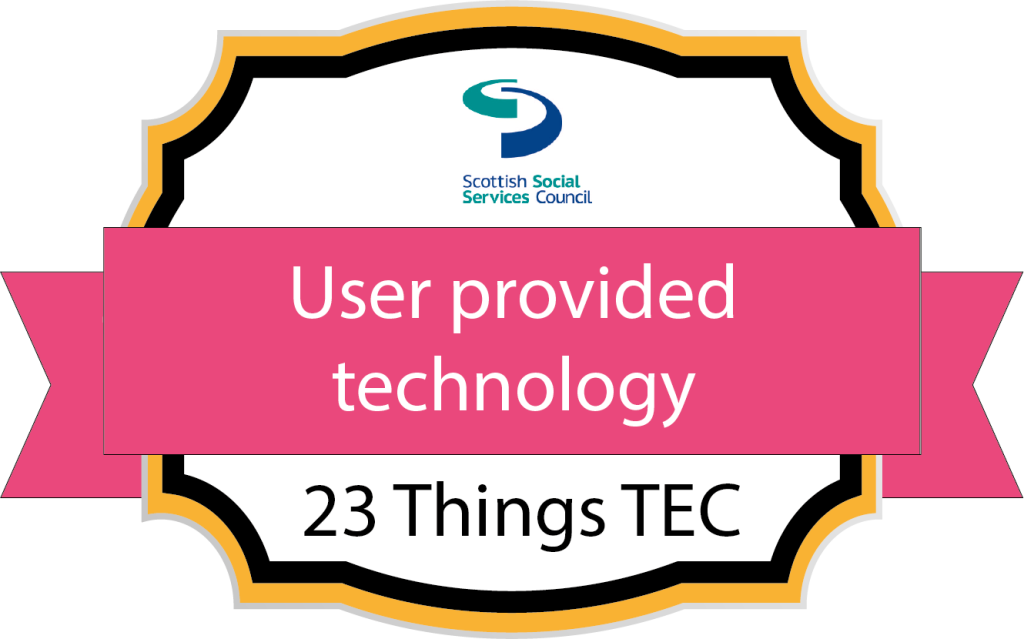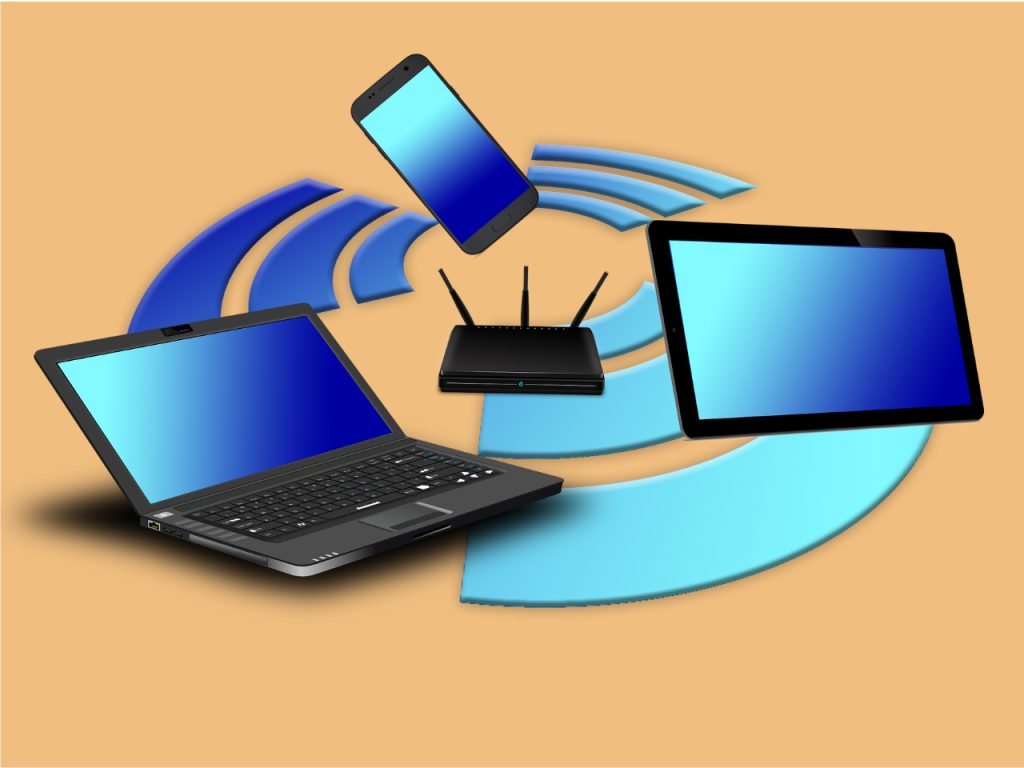Introduction
Wi-Fi is a way of using radio waves to enable devices to communicate with each other over short distances. The name ‘Wi-Fi’ is not an abbreviation of ‘Wireless Fidelity’ as many people believe but was chosen by a group of global companies as a pleasing name that could be used to promote this networking technology.The use of Wi-Fi has transformed the lives of billions of people across the world by enabling them to access information, do daily transactions and communicate with friends, families and organisations. Using Wi-Fi has become almost an expectation for so many of us that we often don’t think about it but how does it work?
MyLearning badge information
MyLearning badge: SSSC 23 Things TEC – Thing 11: Wi-Fi, broadband.

Counts towards the ‘User provided technology‘ milestone badge.

How does Wi-Fi work?

At the heart of a wi-fi network in a device called a router which acts as a link between the internet and devices on your own local network in your home or work. This can communicate with many devices at the same time so for example you could connect smartphones, tablets, TVs and other equipment on the same network. This can be very useful to enable you to share equipment like printers. In the past, if you wanted to print something, you needed to have your printer connected directly to the equipment you were printing from. However, with wi-fi, you only need one printer in your house because all your devices can connect remotely to the printer.
Because the router uses radio waves to transmit data to devices, there are things that you need to think about regarding where you place it. For example, radio waves may find it difficult to go through solid objects like walls, particularly if these are thick and made of stone so, if possible, you should place your router in a fairly central point in your home where the radio waves do not have to travel through a lot of walls to reach the devices.
Another consideration is that the radio waves from most routers used in domestic homes are very weak so do not travel more than a few metres. This is not an issue for most homes, however if you live in a large house, you may find that your devices find it difficult to connect to the router. If this is the case, you can use a signal booster, sometimes called a ‘relay’ to improve the connection.
How Wi-Fi can be used in technology enabled care
One of the biggest benefits of using wi-fi for care is that it can enable people to control their environments remotely. This is particularly useful for people who have issues with mobility or are not able to get out of bed without support. They can use devices like smartphones and tablets to switch on lights, adjust their heating, open windows and curtains, and even control how they watch tv or listen to radio programmes. They can also use voice-controlled digital assistants like Alexa and Siri to do this if they are not able to tap the screens on their phones or tablets. Until the last few years, these types of environmental controls needed very specialised equipment and were expensive to install and run. Wi-fi has enabled this to become much more accessible for everyone.
Security
You need to consider how secure your wi-fi network is. Because wi-fi uses radio waves, if you do not make your network secure, people may be able to access it and the data or information that you are transmitting. This could simply mean that other people could ‘piggy-back’ on to your network using data paid for by you. Far more seriously, it could allow people to access personal data such as passwords and financial information if you use your devices for this.

However, there is no need to panic as networks have security features built in to enable you deny access to anyone who should not be on your one. You have probably noticed when in places that have public wi-fi networks, you need to use a password to join the network. These passwords are usually very simple and easy to type into your device. This is because the networks are open to anyone to use once connected, so the organisations operating the networks know not to use them for sensitive data.
Please remember if you connect to a public network like those in hotels or on trains, people may be able to access what your sensitive data, so never use an unsecured network for doing internet banking or other activities that need to use private information like passwords.
In the same way that your network has a password, your router also has a password to stop people from changing its settings. It is very important to use a strong password to secure your router. When you first get a router, it is likely that it will have a very simple password to let you set it up. A common password for this is ‘Admin’, which is probably the first one that someone will try if they want to access your router. Therefore, as soon as you set up your router, you must change your password to something unique that other people are unlikely to be able to guess. Never use this password for anything else.
Learning activity 1
Rachael lives on her own in her own home, which is an old building with thick walls. Earlier this year she had a stroke which means she now finds it difficult to walk without a walking frame, which she finds tiring. A friend suggested that she might benefit from getting wi-fi but she is not sure what this is. She asks you to explain what it is and how it might benefit her.
Please write a note of at least 150 words about what you would say to Rachael. How might she benefit from having wi-fi? You must also include things that she will need to consider for her security and to make her wi-fi reliable.
Please keep your note as you will need to attach this to an application for the open badge linked to this Thing.
What is broadband?

According to Ofcom, broadband is ‘a way of connecting to the internet. It allows information to be carried at high speed to your personal computer, laptop, tablet, smartphone, smart TV or other web-enabled device.’ It has largely replaced the original ‘dial-up’ (narrowband) method of connecting to the internet, which was much slower.
There are different types of broadband, however the three most common types are Fibre, Cable and ADSL (Asymmetric Digital Subscriber Line).
- Fibre uses fibre optic cables, each one thinner than a human hair, to deliver data to the cabinets in streets. For most subscribers it then uses the copper landlines to connect to the routers in homes. This is known as ‘fibre-to-the-cabinet’ or FTTC. As the copper wires are phased out, more and more people will use ‘fibre-to-the-premises (FTTP) to connect. This has the advantage of being faster than FTTC and is likely to be the most common type of broadband in the next few years.
- Cable uses fibre optic and coaxial cables that are similar to the cables that are used for TV ariels to connect directly to homes. Unlike the older ADSL broadband, the speed of connection is not affected by the distance of your home to the street cabinet. The disadvantage of cable broadband is that it is mainly available in cities and areas of dense population which means it is not accessible across most of Scotland.
- ADSL is the oldest form of broadband and uses the copper cables of telephone lines to connect to homes. It is the slowest of the three types and unlike Fibre and Cable, the speed and quality of the connection gets lower the further away the house is from the street cabinet. As copper telephone lines are phased out, ADSL will also become less available.

You will often need some form of signal adapter (modem) to enable your router to use broadband. In the old ADSL broadband, this is usually a small connector that plugs in between your main telephone socket and the router. For cable and fibre, this is often a box that plugs into your phone line and connects to the router. You can see this in the picture on the right, where the modem is the box on the bottom. The phone line is the cable on the left and the connection that joins the modem to the router above it has pink ends
Nearly all broadband services to homes are provided by telecom companies that charge for this. However, many of these companies have subsidised rates for people who are receiving benefits or are vulnerable so it might be worth checking if people you are supporting are eligible for this. Also, customers who are vulnerable can register this with providers so that the provider can provide additional support or prioritise repairs to phone lines used for telecare.
Learning activity 2
After listening to your description of wi-fi and thinking about some to the benefits she could gain from this, she decides that it might be a good option to get this installed in her house. Her friend told her that she could also use wi-fi to make video calls to her daughter in Canada but would need something called ‘Broadband’ to do this.
Please make a note of at least 100 words to explain what broadband is to Rachael. As you are not sure what type of broadband she would need, please explain the different types to her and the equipment that she may require to enable her wi-fi network to connect to her phone line.
Please keep this note so you can attach it to your badge application for this thing.
